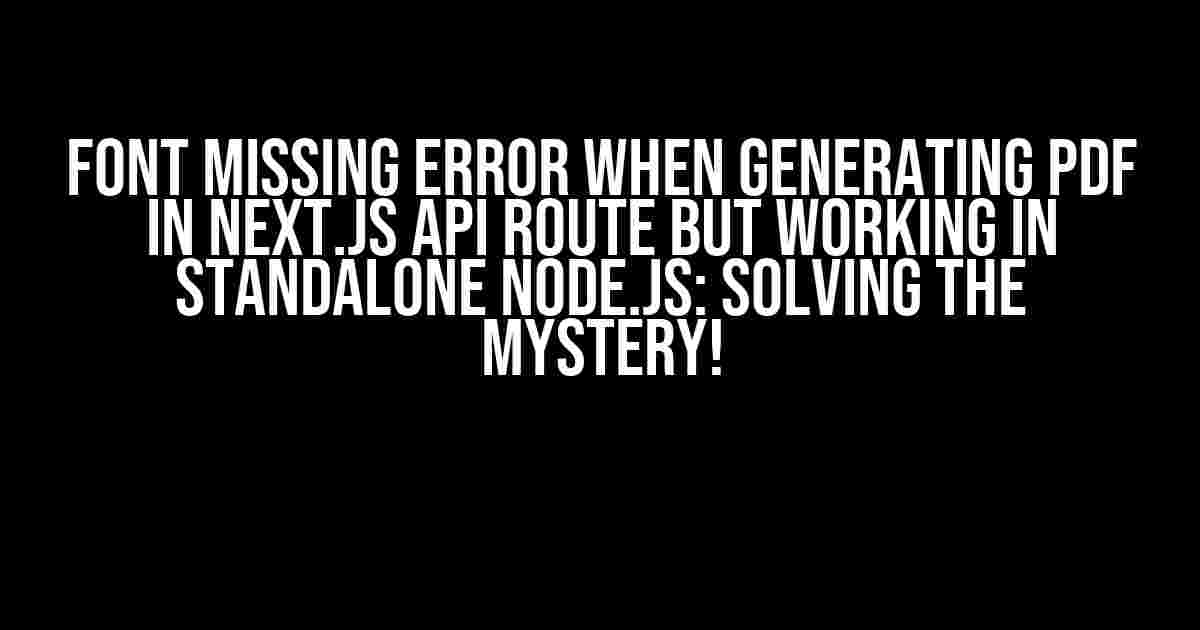Have you ever encountered the frustrating font missing error when generating PDFs in a Next.js API route, only to find that it works seamlessly in a standalone Node.js environment? You’re not alone! This phenomenon has puzzled many developers, leaving them scratching their heads and searching for answers. Worry no more, dear reader, for in this article, we’ll delve into the heart of this issue and provide you with a clear, step-by-step guide to solving this enigmatic problem.
Understanding the Problem
The font missing error typically manifests as a PDF generation failure, with the error message citing a missing font file. This can occur when using libraries like `pdfMake` or `jsPDF` to generate PDFs in a Next.js API route. Curiously, the same code works flawlessly in a standalone Node.js environment, leading to even more confusion.
Why Does This Happen?
The primary reason behind this issue lies in the way Next.js handles server-side rendering (SSR) and API routes. When a request is made to an API route, Next.js creates a new instance of the Node.js environment, which lacks access to the file system and fonts. This is in contrast to a standalone Node.js environment, where the Node.js process has direct access to the file system and fonts.
Solving the Font Missing Error
Now that we understand the cause, let’s dive into the solutions! We’ll explore three distinct approaches to tackle this issue:
Approach 1: Using Absolute Font Paths
In this approach, we’ll specify absolute font paths to ensure that the fonts are accessible within the Next.js API route.
import { createPdf } from 'pdfMake';
const fontDescriptors = {
Roboto: {
normal: 'path/to/fonts/Roboto-Regular.ttf',
bold: 'path/to/fonts/Roboto-Bold.ttf',
italics: 'path/to/fonts/Roboto-Italic.ttf',
bolditalics: 'path/to/fonts/Roboto-BoldItalic.ttf'
}
};
const pdfDoc = createPdf({
content: 'Hello World!',
fontDescriptors
});
res.setHeader('Content-Type', 'application/pdf');
res.setHeader('Content-Disposition', 'attachment; filename="example.pdf"');
res.send(pdfDoc);
In the above example, we’ve specified absolute font paths using the `fontDescriptors` object. This tells `pdfMake` to use the fonts located at the specified paths.
Approach 2: Copying Fonts to a Temp Directory
In this approach, we’ll create a temporary directory within the Next.js API route and copy the required fonts to it. This allows the `pdfMake` library to access the fonts during PDF generation.
import { createPdf } from 'pdfMake';
import fs from 'fs';
import path from 'path';
import { tmpdir } from 'os';
const tempDir = fs.mkdtempSync(`${tmpdir()}font-temp-`);
const fontFiles = ['Roboto-Regular.ttf', 'Roboto-Bold.ttf', 'Roboto-Italic.ttf', 'Roboto-BoldItalic.ttf'];
fontFiles.forEach((fontFile) => {
const srcPath = path.join(__dirname, '..', 'fonts', fontFile);
const destPath = path.join(tempDir, fontFile);
fs.copyFileSync(srcPath, destPath);
});
const fontDescriptors = {
Roboto: {
normal: path.join(tempDir, 'Roboto-Regular.ttf'),
bold: path.join(tempDir, 'Roboto-Bold.ttf'),
italics: path.join(tempDir, 'Roboto-Italic.ttf'),
bolditalics: path.join(tempDir, 'Roboto-BoldItalic.ttf')
}
};
const pdfDoc = createPdf({
content: 'Hello World!',
fontDescriptors
});
res.setHeader('Content-Type', 'application/pdf');
res.setHeader('Content-Disposition', 'attachment; filename="example.pdf"');
res.send(pdfDoc);
// Clean up temp directory
fs.rmdirSync(tempDir, { recursive: true });
In this example, we create a temporary directory using the `tmpdir()` function from the `os` module. We then copy the required font files to this directory using the `fs` module. Finally, we specify the font paths using the `fontDescriptors` object, pointing to the copied font files within the temp directory.
Approach 3: Using a Font Loader Library
In this approach, we’ll utilize a font loader library like `fontloader` to load the fonts programmatically, making them accessible within the Next.js API route.
import { createPdf } from 'pdfMake';
import { load } from 'fontloader';
const font = await load('path/to/fonts/Roboto-Regular.ttf');
const pdfDoc = createPdf({
content: 'Hello World!',
fontDescriptors: {
Roboto: {
normal: font
}
}
});
res.setHeader('Content-Type', 'application/pdf');
res.setHeader('Content-Disposition', 'attachment; filename="example.pdf"');
res.send(pdfDoc);
In this example, we use the `fontloader` library to load the Roboto font programmatically. We then pass the loaded font object to the `fontDescriptors` object, which allows `pdfMake` to use the font during PDF generation.
Conclusion
The font missing error when generating PDFs in Next.js API routes can be a frustrating issue, but with the approaches outlined above, you’ll be well-equipped to tackle it. By using absolute font paths, copying fonts to a temp directory, or employing a font loader library, you can ensure that your PDF generation process runs smoothly and efficiently.
Remember, the key to resolving this issue lies in providing `pdfMake` (or your chosen PDF generation library) with access to the required fonts. By doing so, you’ll be able to generate beautiful, font-rendered PDFs within your Next.js API routes.
Bonus Section: Troubleshooting Tips
Here are some additional troubleshooting tips to help you resolve font-related issues when generating PDFs in Next.js API routes:
- Verify that the font files are correctly located and accessible within your project.
- Check that the font file paths are correct and properly formatted.
- Ensure that the font loader library is properly installed and imported.
- Verify that the temp directory is correctly created and cleaned up after use (if using Approach 2).
- Inspect the generated PDF to ensure that the fonts are being rendered correctly.
| Approach | Advantages | Disadvantages |
|---|---|---|
| Approach 1 (Absolute Font Paths) |
|
|
| Approach 2 (Copying Fonts to Temp Directory) |
|
|
| Approach 3 (Using a Font Loader Library) |
|
|
We hope this article has provided you with a comprehensive guide to resolving font missing errors when generating PDFs in Next.js API routes. Remember to carefully evaluate each approach and choose the one that best suits your project’s requirements.
Happy coding, and may the fonts be ever in your favor!
Frequently Asked Question
Got stuck with font missing errors while generating PDFs in Next.js API routes, but it works like a charm in standalone Node.js? We’ve got you covered!
Why does the font missing error occur in Next.js API routes but not in standalone Node.js?
The reason behind this error is that Next.js uses a different environment and configuration compared to standalone Node.js. In Next.js, the API routes are executed in a serverless environment, which can lead to differences in font loading and rendering.
How do I troubleshoot the font missing error in Next.js API routes?
To troubleshoot the issue, try checking the font files’ availability and loading in your Next.js project. Ensure that the font files are correctly imported and referenced in your code. You can also try using a different font or checking the PDF generation library’s documentation for any specific requirements or workarounds.
Can I use a CDN to load fonts in my Next.js API routes?
Yes, you can use a CDN to load fonts in your Next.js API routes. This can help bypass any font loading issues related to the serverless environment. Just make sure to update your code to reference the CDN-hosted font files correctly.
Are there any specific PDF generation libraries that work well with Next.js API routes?
While most PDF generation libraries can work with Next.js API routes, some popular ones like `pdfMake`, `jsPDF`, and `pdfkit` have been known to work well. However, it’s essential to check the library’s documentation and community support for any specific issues or workarounds related to Next.js.
How can I ensure that my PDF generation code is compatible with both Next.js API routes and standalone Node.js?
To ensure compatibility, follow best practices for PDF generation in Node.js and use libraries that are well-maintained and widely adopted. Avoid using environment-specific code or dependencies, and instead, focus on using pure JavaScript and standard Node.js modules. This will help ensure that your code works seamlessly in both Next.js API routes and standalone Node.js environments.



